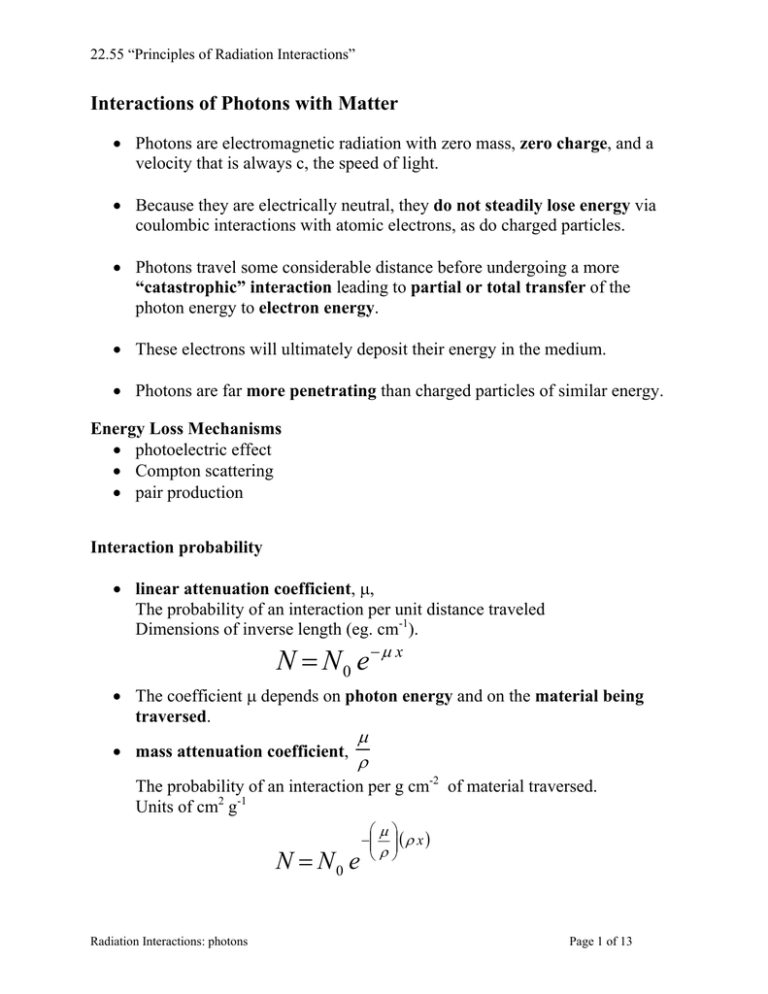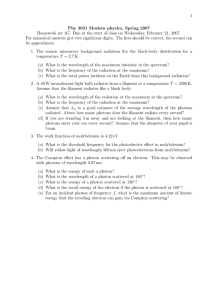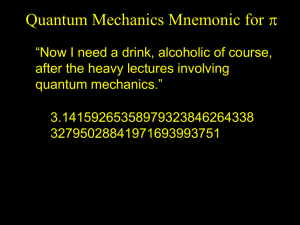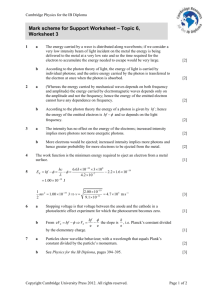Interactions of Photons with Matter
advertisement

22.55 “Principles of Radiation Interactions” Interactions of Photons with Matter • Photons are electromagnetic radiation with zero mass, zero charge, and a velocity that is always c, the speed of light. • Because they are electrically neutral, they do not steadily lose energy via coulombic interactions with atomic electrons, as do charged particles. • Photons travel some considerable distance before undergoing a more “catastrophic” interaction leading to partial or total transfer of the photon energy to electron energy. • These electrons will ultimately deposit their energy in the medium. • Photons are far more penetrating than charged particles of similar energy. Energy Loss Mechanisms • photoelectric effect • Compton scattering • pair production Interaction probability • linear attenuation coefficient, µ, The probability of an interaction per unit distance traveled Dimensions of inverse length (eg. cm-1). −µ x N = N0 e • The coefficient µ depends on photon energy and on the material being traversed. • mass attenuation coefficient, µ ρ The probability of an interaction per g cm-2 of material traversed. Units of cm2 g-1 N = N0 e Radiation Interactions: photons ⎛µ −⎜⎜ ⎝ρ ⎞ ⎟⎟ ( ρ x ) ⎠ Page 1 of 13 22.55 “Principles of Radiation Interactions” Mechanisms of Energy Loss: Photoelectric Effect • In the photoelectric absorption process, a photon undergoes an interaction with an absorber atom in which the photon completely disappears. • In its place, an energetic photoelectron is ejected from one of the bound shells of the atom. • For gamma rays of sufficient energy, the most probable origin of the photoelectron is the most tightly bound or K shell of the atom. • The photoelectron appears with an energy given by Ee- = hv – Eb (Eb represents the binding energy of the photoelectron in its original shell) Thus for gamma-ray energies of more than a few hundred keV, the photoelectron carries off the majority of the original photon energy. Filling of the inner shell vacancy can produce fluorescence radiation, or x ray photon(s). [Image removed due to copyright considerations] Radiation Interactions: photons Page 2 of 13 22.55 “Principles of Radiation Interactions” The photoelectric process is the predominant mode of photon interaction at o relatively low photon energies o high atomic number Z The probability of photoelectric absorption, symbolized τ (tau), is roughly proportional to Zn τ ∝ ( hν ) 3 where the exponent n varies between 3 and 4 over the gamma-ray energy region of interest. This severe dependence of the photoelectric absorption probability on the atomic number of the absorber is a primary reason for the preponderance of high-Z materials (such as lead) in gamma-ray shields. The photoelectric interaction is most likely to occur if the energy of the incident photon is just greater than the binding energy of the electron with which it interacts. [Image removed due to copyright considerations] Radiation Interactions: photons Page 3 of 13 22.55 “Principles of Radiation Interactions” Compton Scattering • Compton scattering takes place between the incident gamma-ray photon and an electron in the absorbing material. • It is most often the predominant interaction mechanism for gamma-ray energies typical of radioisotope sources. • It is the most dominant interaction mechanism in tissue. [Image removed due to copyright considerations] In Compton scattering, the incoming gamma-ray photon is deflected through an angle θ with respect to its original direction. The photon transfers a portion of its energy to the electron (assumed to be initially at rest), which is then known as a recoil electron, or a Compton electron. • All angles of scattering are possible. • The energy transferred to the electron can vary from zero to a large fraction of the gamma-ray energy. Radiation Interactions: photons Page 4 of 13 22.55 “Principles of Radiation Interactions” • The Compton process is most important for energy absorption for soft tissues in the range from 100 keV to 10MeV. • The Compton scattering probability is is symbolized σ (sigma): • almost independent of atomic number Z; • decreases as the photon energy increases; • directly proportional to the number of electrons per gram, which only varies by 20% from the lightest to the heaviest elements (except for hydrogen). Compton Scattering Energetics The energies of the scattered photon hν ' and the Compton electron Ee, are given by hν ' = h ν 1 1 + α (1 − cos θ ) α (1 − cosθ ) Ee = hν 1 + α (1 − cosθ ) where hν α= m0 c 2 [ m0 c 2 is the electron rest energy, 0.511 MeV, hν is the incoming photon energy] Radiation Interactions: photons Page 5 of 13 22.55 “Principles of Radiation Interactions” Limits of Energy Loss Maximum energy transfer to recoil electron: • angle of electron recoil is forward at 0°, φ = 0°, • the scattered photon will be scattered straight back, θ = 180° • With θ = 180°, cos θ = -1 the expressions above simplify to: Ee(max) = hv 2α 1 + 2α and ' hv min = hv 1 1 + 2α The Table below illustrates how the amount of energy transferred to the electron varies with photon energy. Energy transfer is not large until the incident photon is in excess of approximately 100 keV. For low-energy photons, when the scattering interaction takes place, little energy is transferred, regardless of the probability of such an interaction. As the energy increases, the fractional transfer increases, approaching 1.0 for photons at energies above 10 to 20 MeV. Radiation Interactions: photons Page 6 of 13 22.55 “Principles of Radiation Interactions” Pair Production If a photon enters matter with an energy in excess of 1.022 MeV, it may interact by a process called pair production. The photon, passing near the nucleus of an atom, is subjected to strong field effects from the nucleus and may disappear as a photon and reappear as a positive and negative electron pair. The two electrons produced, e- and e+, are not scattered orbital electrons, but are created, de novo, in the energy/mass conversion of the disappearing photon. [Image removed due to copyright considerations] Pair Production Energetics The kinetic energy of the electrons produced will be the difference between the energy of the incoming photon and the energy equivalent of two electron masses (2 x 0.511, or 1.022 MeV). Ee+ + Ee- = hν - 1.022 (MeV) Pair production probability, symbolized κ (kappa), • Increases with increasing photon energy • Increases with atomic number approximately as Z2 Radiation Interactions: photons Page 7 of 13 22.55 “Principles of Radiation Interactions” (a) Compton scattering [Image removed due to copyright considerations] (b) Photoelectric effect (c) Pair production [Image removed due to copyright considerations] • Photoelectric effect: produces a scattered photon and an electron, varies as ~ Z4/E3 • Compton effect: produces an electron, varies as ~ Z • Pair production: produces an electron and a positron, varies as ~Z2 Radiation Interactions: photons Page 8 of 13 22.55 “Principles of Radiation Interactions” Bulk Behavior of Photons in an Absorber Attenuation Coefficients Linear attenuation coefficient µ: The probability of an interaction per unit distance traveled. µ has the dimensions of inverse length (eg. cm-1). N = N0 e− µ x The coefficient µ depends on photon energy and on the material being traversed. [Image removed due to copyright considerations] Radiation Interactions: photons Page 9 of 13 22.55 “Principles of Radiation Interactions” [Image removed due to copyright considerations] The mass attenuation coefficient, µ /ρ, is obtained by dividing µ by the density ρ of the material, usually expressed in cm2g-1. [Image removed due to copyright considerations] Radiation Interactions: photons Page 11 of 13








